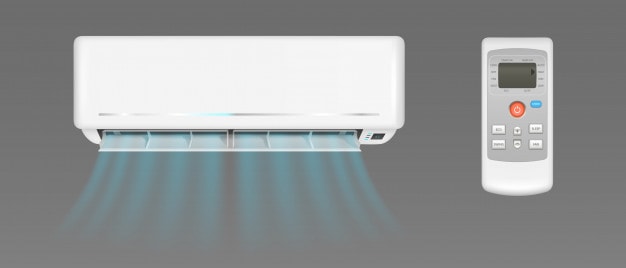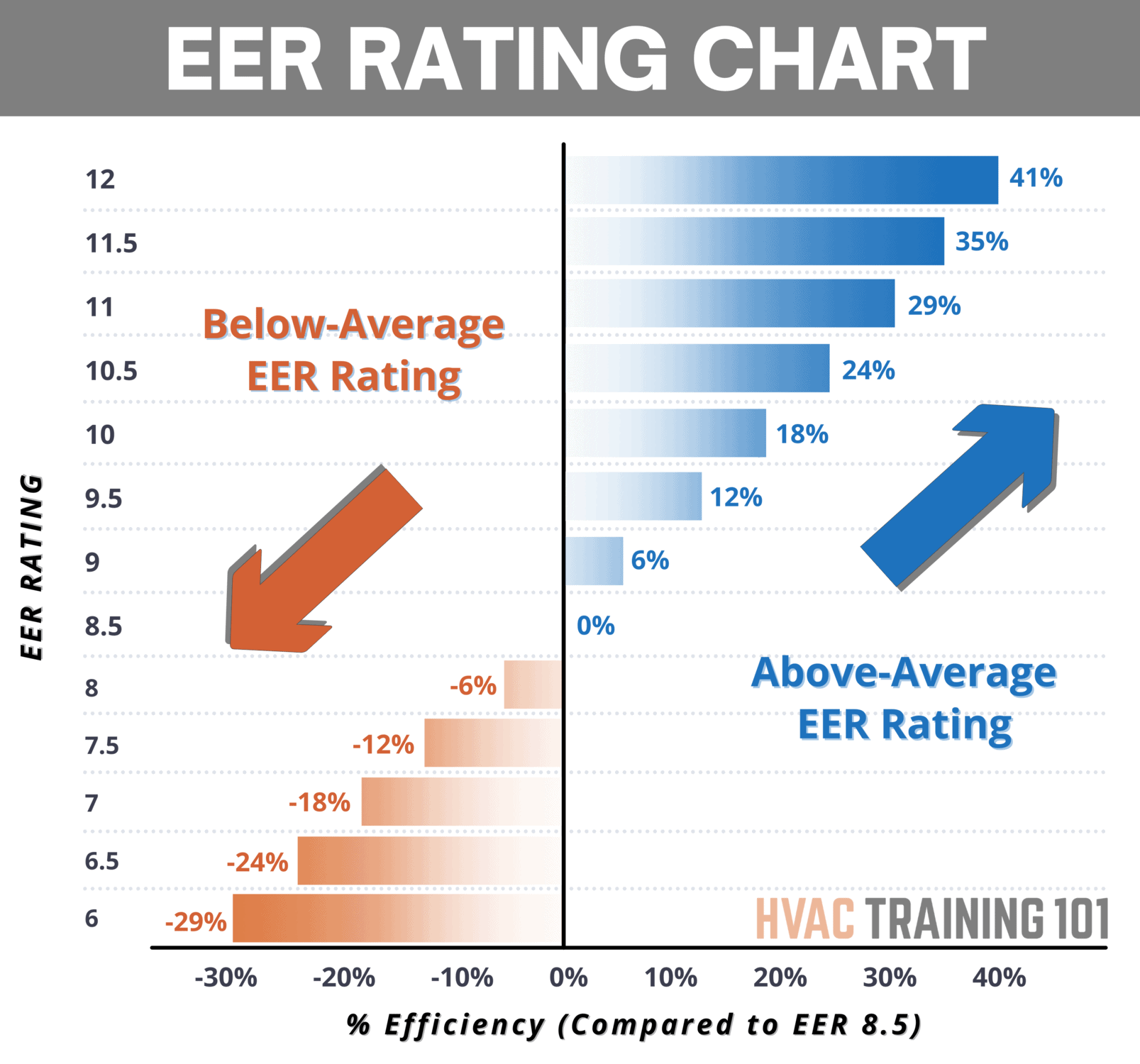Keen to know more about EER?
Perhaps you have heard the term before but have no idea how this will relate to you? Or have you purchased your AC unit and are unsure how efficient it is?
Well, that is where EER ratings come in! The energy efficiency ratio might be mind-boggling to you, but after today that will be no more! We have the complete EER Rating Beginner’s Guide providing everything you need to know! Keep reading to find out more.

How EER Ratings Are Determined
Some factors determine EER Ratings. The weather is one of the main factors used to determine the ratings. EER ratings are generally measured on the hottest day of the year to provide an accurate energy efficiency rating when the AC works at full pelt.
EER ratings consider the weather and humidity conditions when it is determined too and the average cost of an energy bill. These can be fantastic indicators of the running cost of an electrical item with an EER rating, especially air conditioning units.
We will look at the calculation to work out EER ratings, later on, so be sure to keep reading to find out more!
What is EER?
EER or Energy Efficiency Ratio is a measure used to determine how well an HVAC device uses energy. EER ratings are attributed to an air conditioner or heat pump. The higher the EER rating, the more efficient your unit will be in terms of energy usage.
The EER rating will be listed in the specifications section of your AC unit user manual. You can also find it on an Energy Guide label that shows how much energy you can expect the AC unit to use. Often, the average cost of electricity prices will also be included there.
EER is useful in determining the cost of running your air conditioning unit. In more extensive commercial or industrial settings, these can result in massive economic savings. This is true of your home, too; opting for an efficient air conditioner will save you money on your energy bills.
Energy Efficiency Ratio is not the only rating used to determine an air conditioning unit’s efficiency either. SEER, CEER, and COP relate to an air conditioning or electrical unit’s overall performance and energy usage. We can consider these in isolation or relation to one another when selecting an efficient air conditioning unit.

How is EER Calculated?
So how do we calculate EER? We do this by dividing the BTU (British Thermal Units) rating by the wattage of the air conditioner. Let’s use an example. Say your air conditioner has a 12,000 BTU rating and uses 1,200 watts.
We would use the following calculation: 12,000/1,200 to get the result of 10. This ten will then be your air conditioner’s EER rating of 10. The measurement has been based on an operating air conditioner using an outside temperature of 95 degrees Fahrenheit.
The calculation will look like the following:
EER Rating = Capacity (in BTU)/Power (in W)
The calculation is easy to perform if the EER rating is not already calculated and listed on the product’s specifications. When calculating EER, it is often completed on the hottest day of the year, using 95 degrees Fahrenheit as its temperature.
However, if you are calculating the EER rating yourself, you can use an outdoor temperature related to your area. Simply choose the hottest day or what they have been previously when considering the rating.
It is worth remembering that the EER calculation does not consider the energy usage on hotter days where your AC will run for extended periods.
EER Ratings Chart
The average EER rating falls at about 8.5. The graph below shows percentages of how much more or less efficient a unit with various EER ratings is. For example: a unit with an EER of 10 is 18% more efficient than one with an 8.5 rating, while a unit with an EER of 7 is 18% less efficient than average.

What is the COP Rating, and How Does it Relate to the EER?
The COP rating is the coefficient of performance. It is used to indicate the heating or cooling provided by a unit and relate it to the electrical input needed to generate the AC.
As a general rule, the higher the COP and EER rating, the more efficient the unit shall be. To get the COP rating of a product, you will divide the output heating or cooling in Wh by the input electrical energy.
Often the calculation has already been done for you, or there are sites in operation that will convert the EER or other ratings into a coefficient of performance for you.
How does this relate to EER ratings? COP is the equivalent measure using SI units that we see more commonly used in the UK. Generally, a COP of 1.0 would equate to an EER of 3.4. These are advertised as equivalents when considering the carbon emissions of a device.
In terms of your air conditioning unit, the higher a COP would suggest it is an efficient unit in terms of both emissions and performance. Similarly to how a high EER rating indicates the product is efficient.
When it comes to an understanding of the energy ratings and usage of your air conditioner, you are better consulting the EER rating rather than the COP. Although the performance is essential, EER will provide a more accurate and insightful input than COP will.
What About SEER and CEER Ratings?
SEER and CEER ratings should also be considered when looking at EER ratings related to your AC units. Let’s take a closer look at these ratings now and their importance today.
SEER Ratings

SEER is the Seasonal Energy Efficiency Ratio. These ratings take an average EER and measure it over a range of outside temperatures, often between 65 to 104 degrees Fahrenheit.
SEER is considered an average energy rating compared to EER, which measures the energy efficiency during the hottest time of the year. These are considered more accurately reflecting the usage of a system than EER as the whole year is accounted for, rather than just the hottest day.
It is worth noting the SEER rating for those who will be using their air conditioning units in a range of temperatures, not just the hottest day of the year.
CEER Ratings
CEER rating is the combined energy efficiency ratio that measures an air conditioner unit’s combined efficiency when on standby and powered and cooling an area.
Generally speaking, the higher the number is, the more efficient the AC unit will be. These ratings are not entirely accurate, though, offering a usage cost for the units.
CEER ratings help understand the overall energy rating of the air conditioning unit, especially when paired with SEER and EER ratings.
Are EER Ratings Reliable?
EER ratings are reliable, but they are not without their limitations. They can be significant indicators of the energy used by your AC unit; there will be discrepancies that need to be considered. Let’s take a quick look at those now.
Does Heat Affect the EER?
The heat does indeed affect EER. In hotter climates, the AC unit will need to work harder and use more energy to keep the space at the desired temperature. In these cases, the energy usage will increase and can impact the EER.

Often, EER ratings are taken at an outdoor temperature of 95 degrees Fahrenheit. If you are in temperatures above this, your AC might use more energy to lower the temperature and keep the desired space cool.
While the heat affects the EER, if you live in a similar climate to the ones used to determine EER, it should not impact its reliability.
Does Humidity Affect the EER?
In some cases, yes, humidity can affect the EER. When the humidity levels are high, it can cause a temperature rise, meaning our AC units need to be on for longer and work harder to lower the temperature, using more energy.
When the humidity is high, using your AC unit can cause the energy usage to soar, meaning that you will use more than the EER rating would suggest. However, that does not imply that the EER rating is unreliable.
EER ratings are taken at higher temperatures, as we mentioned earlier, with the humidity level also considered. It is best to consider them as a guide rather than an exact number.
If you live in an extremely warm and humid climate, you will probably see energy usage higher than the EER rate. Consider your climate when looking at the ratings and any possible implications of higher temperatures.
How to Use the EER Rating When Purchasing an Air Conditioner
EER ratings are incredibly useful when purchasing an air conditioner, but it should not be the only factor you consider. As we have seen, EER ratings are not always 100% accurate, particularly for those living in warmer and humid climates.
Using the EER rating as more of a guide when purchasing is a good approach. After all, you don’t want an AC unit that is not efficient, do you? Consider not only the EER rating but the size of your air conditioner, its cost, durability, durability, and ease of installation.
It is vital to look at other factors outside of energy efficiency. There is no point in buying an efficient AC unit if it won’t be powerful enough to cool your desired area.

Final Word
Here we are, the end of the road. As you can see, EER ratings look at the energy efficiency of your AC unit. They provide you with a clear indication of the amount of energy your unit will use and can be crucial for selecting your new AC unit.
These ratings are impacted by the weather, mainly the heat and humidity, and provide great insight for those looking to cool down in warmer climates. These ratings can be used in conjunction with SEER and COP to find the perfect AC for you.
People Also Ask
Got any last-minute questions you need to answer? Check out popular questions other users ask for some help!
When it comes to your AC, a rating of 12 or above is ideal. These will provide excellent energy efficiency during use. There is some leeway here. For example, if you are purchasing a window AC, then an EER rating of 10 is considered good.
When searching for your AC, keep 12 as the figure for a good EER rating, and you will be sure to find the perfect AC for you!
The importance of SEER and EER will vary depending on the climate you live in. if you like in an environment where it is 95 degrees Fahrenheit most of the time the AC unit is on, then the EER will be more critical. It will show you how much energy your AC will be used as it performs in these warmer temperatures.
However, in moderate climates, the SEER is a better measurement, as it looks at an average rather than warmer temperatures your AC will be powered on.
Yes, we think an AC with a higher EER rating is worth the extra cost!
Although it can be more money to put down upfront, an AC unit with a higher EER rating will use less energy. In the long-term, this will save you money on hefty energy bills during hot summers!
You can find the BTU and Watts for your AC in a few different places. The user manual of your AC unit will have the BTU and wattage listed, allowing you to calculate your ACs EER rating.
You can also find the BTU and Watts listed on the product specifications on product listings or the AC box.
AHRI, or air-conditioning, heating, and refrigeration institute, is a trade association that represents manufacturers of heating, cooling, water heating, and commercial refrigeration equipment.
How do you get AHRI certification? There are rigorous and unbiased tests that your item must pass before its energy efficiency is verified. AHRI certification will show that your EER rating is accurate and meets the correct efficiency ratings required.
In warmer, southern climates, an EER rating of 11 or over is considered a good EER rating. In these climates, a higher EER rating is advantageous as it will provide excellent cooling power without high energy bills.
Lower ratings will use more energy in warmer climates, costing you more in the long-term.
In temperate, northern climates, an EER rating of between 10 and 11 is a good EER rating. As the temperature won’t be as warm and humid, you won’t need an AC unit with a higher EER rating. You won’t be using as much energy and therefore should not experience higher energy bills.
